Central and Southern Asia China Japan China is
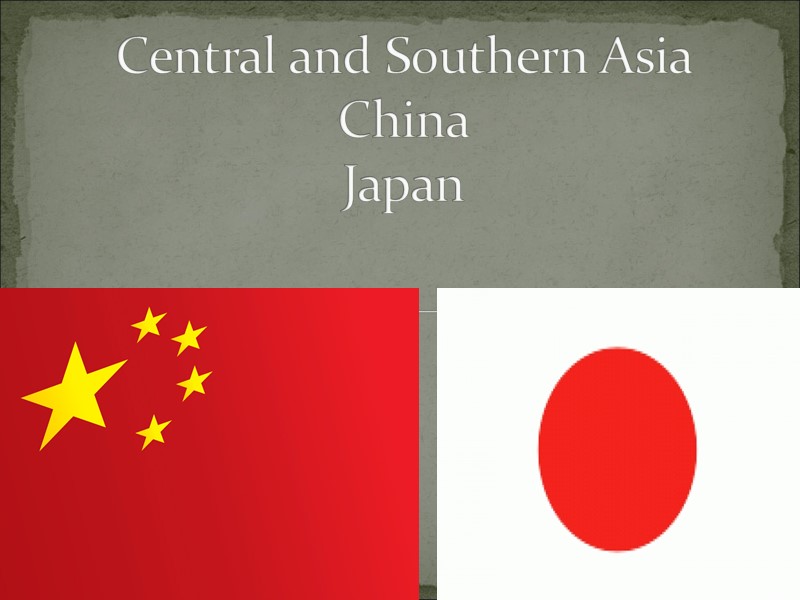
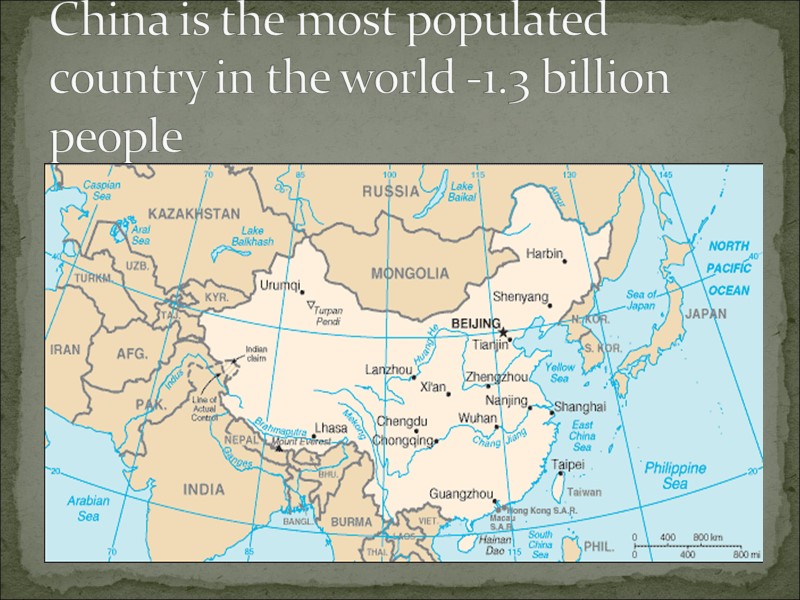
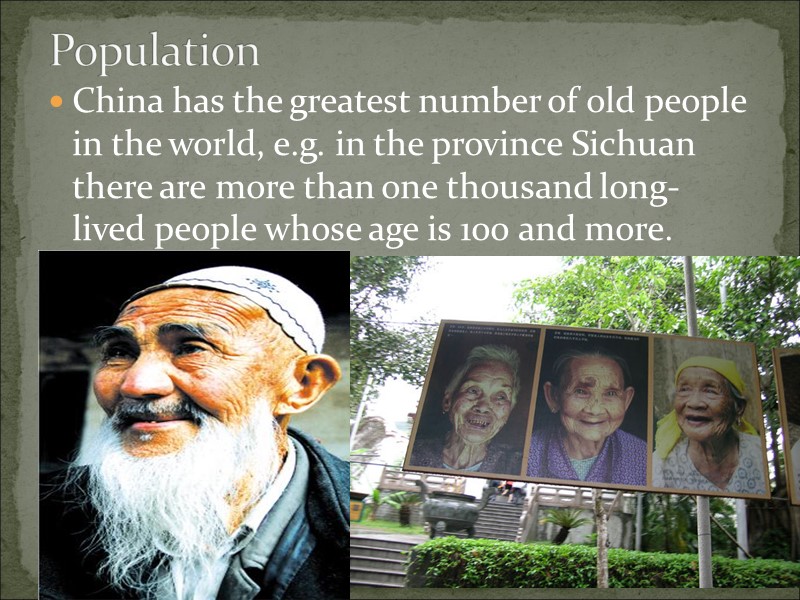
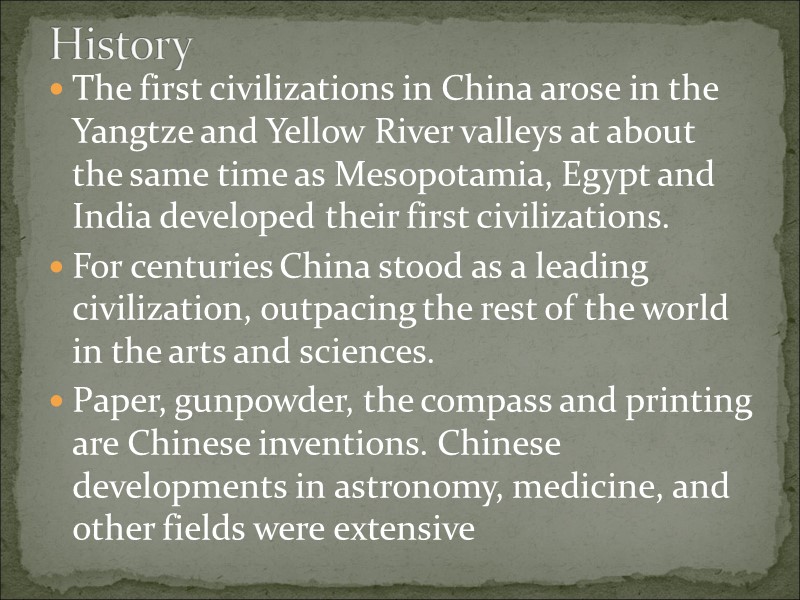
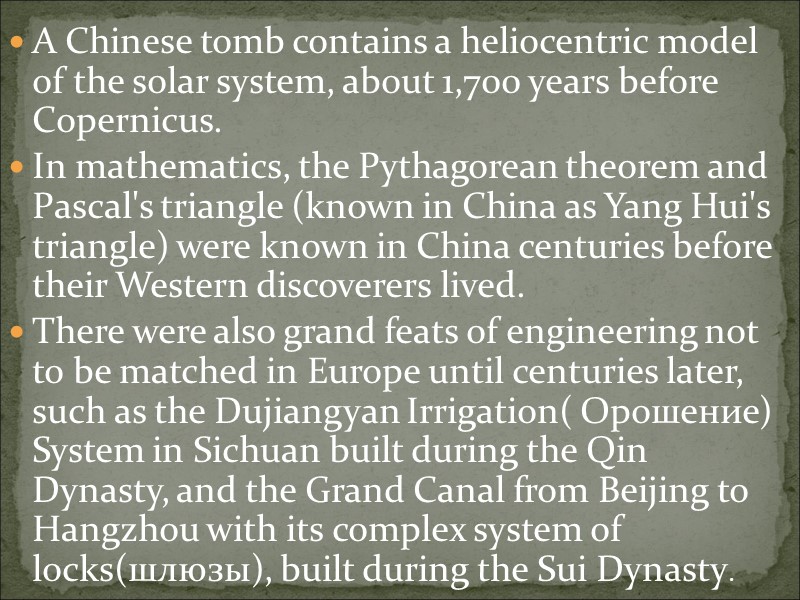
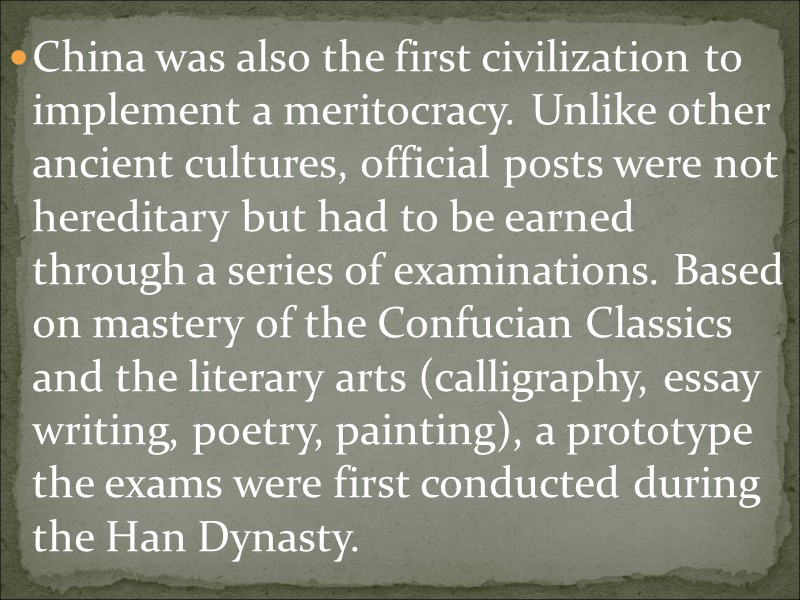
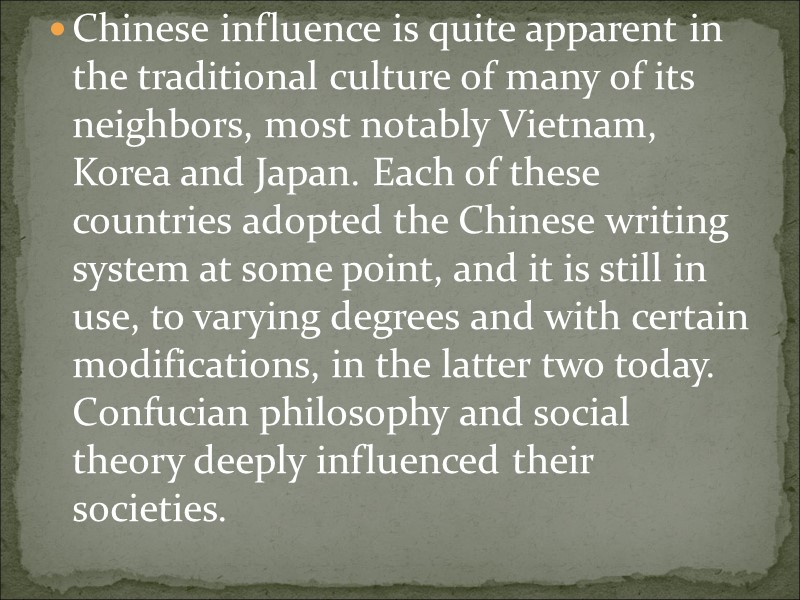
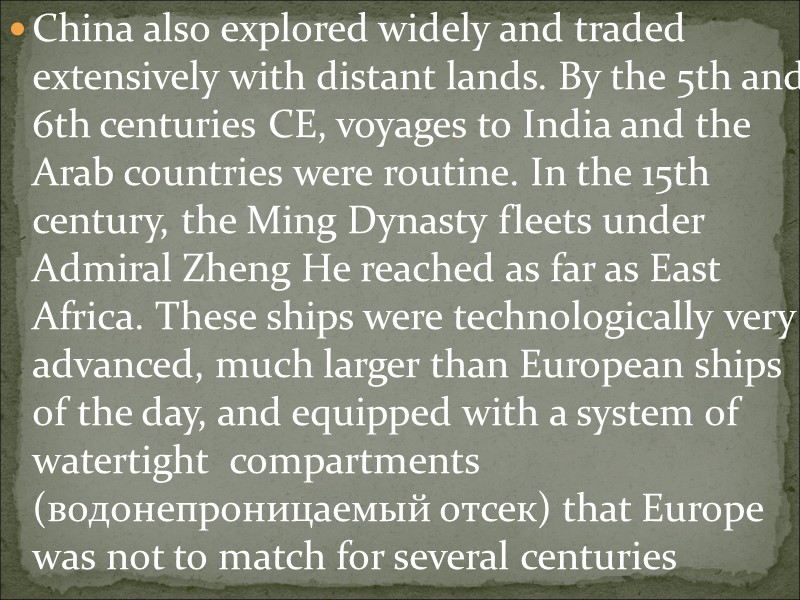
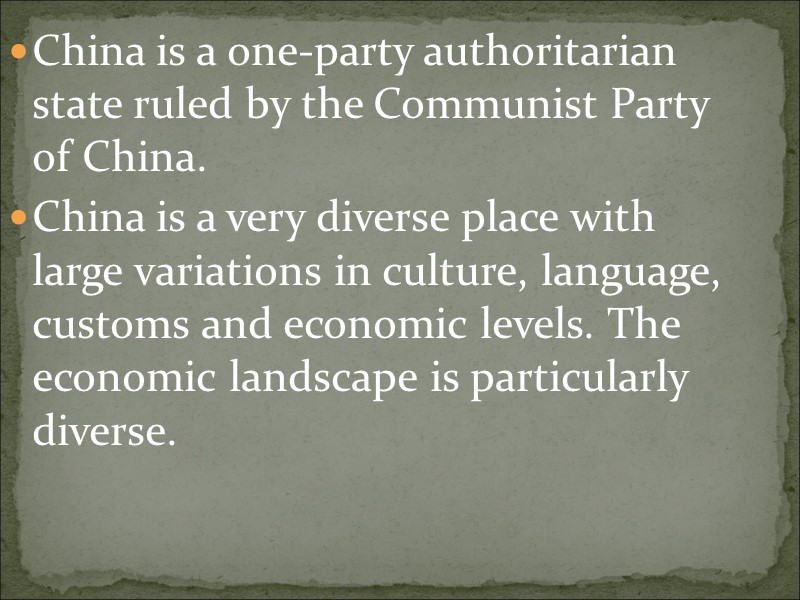
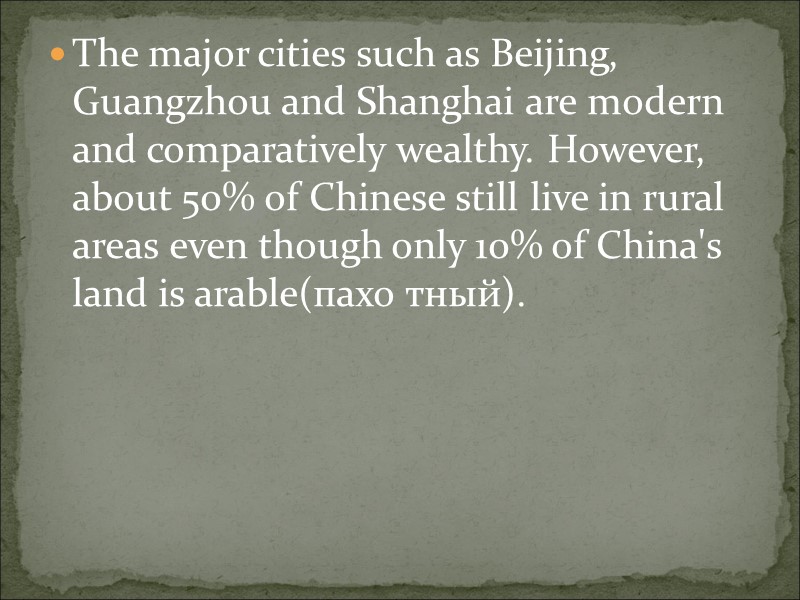
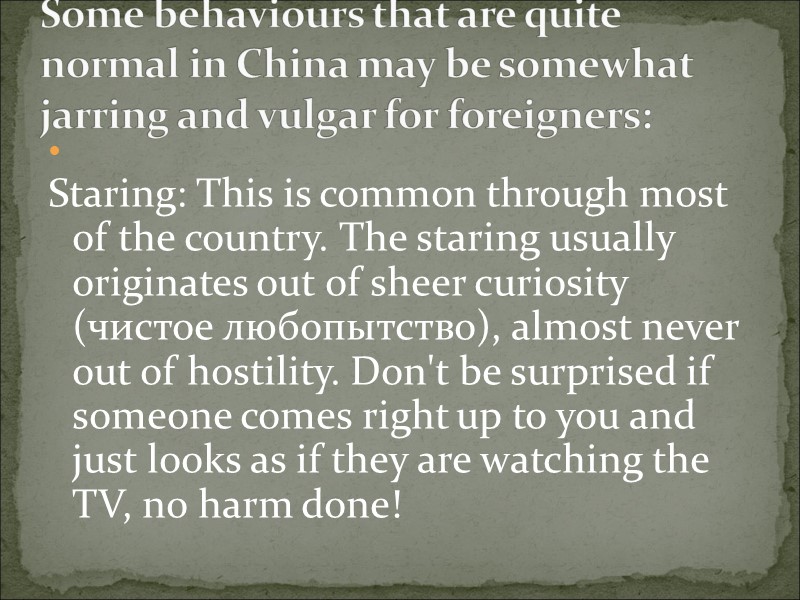
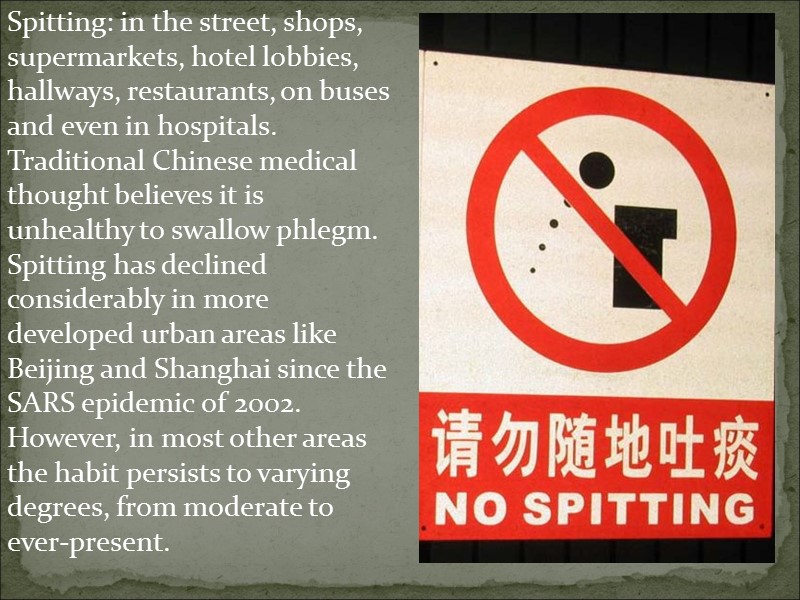
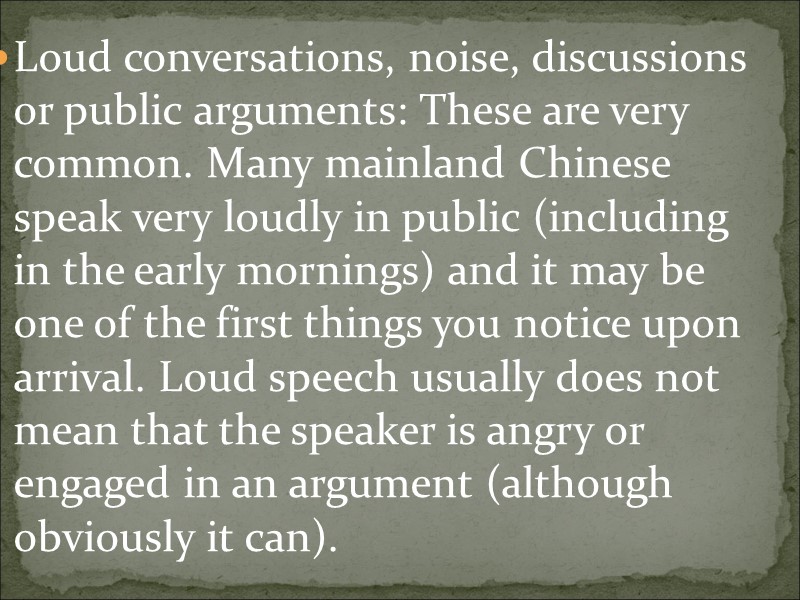

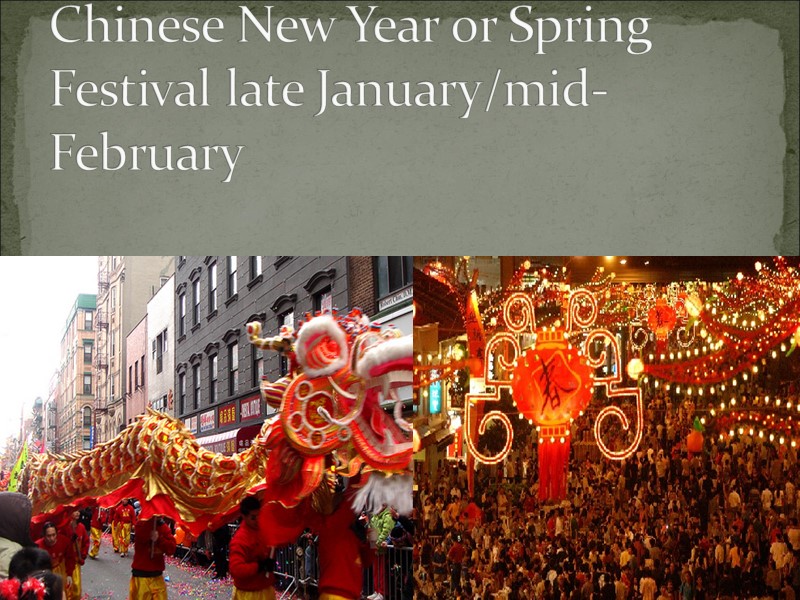
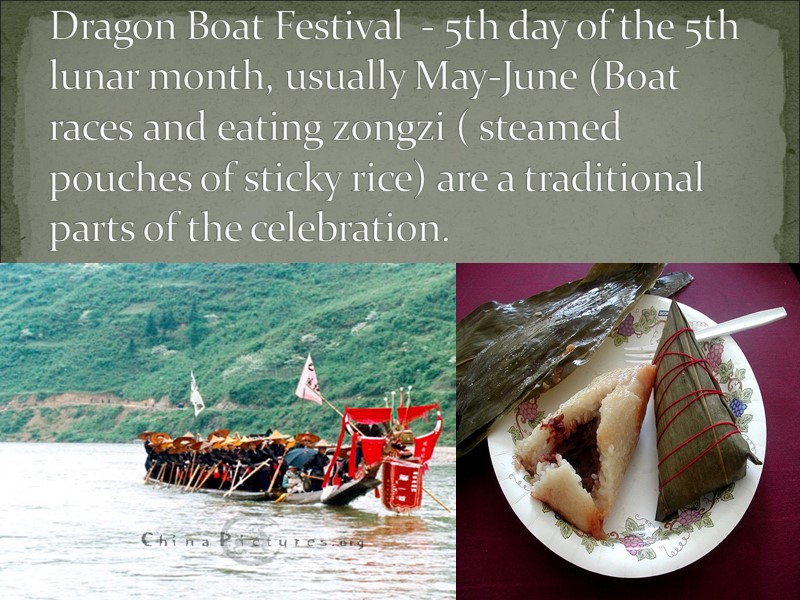
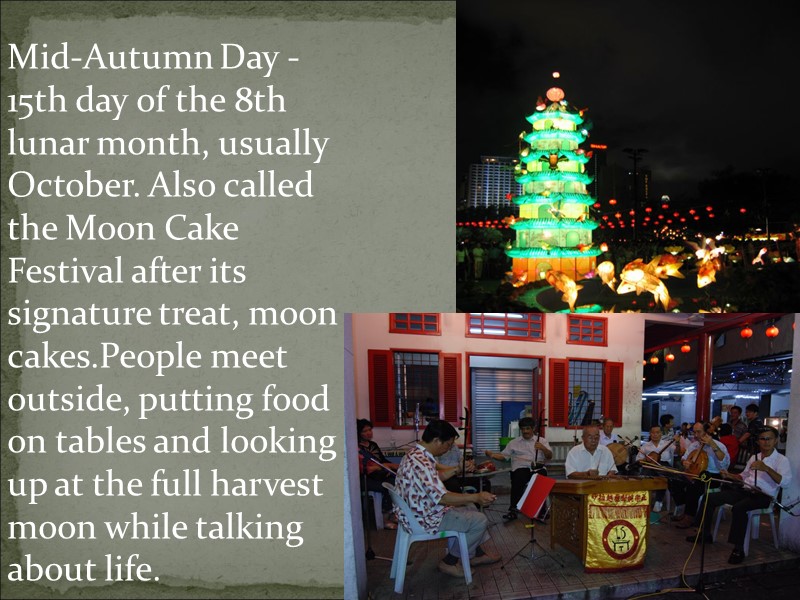
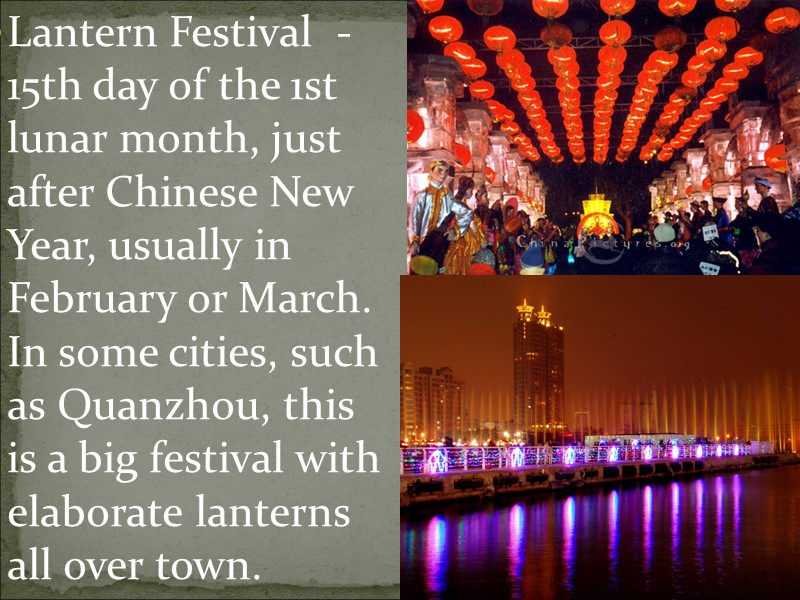
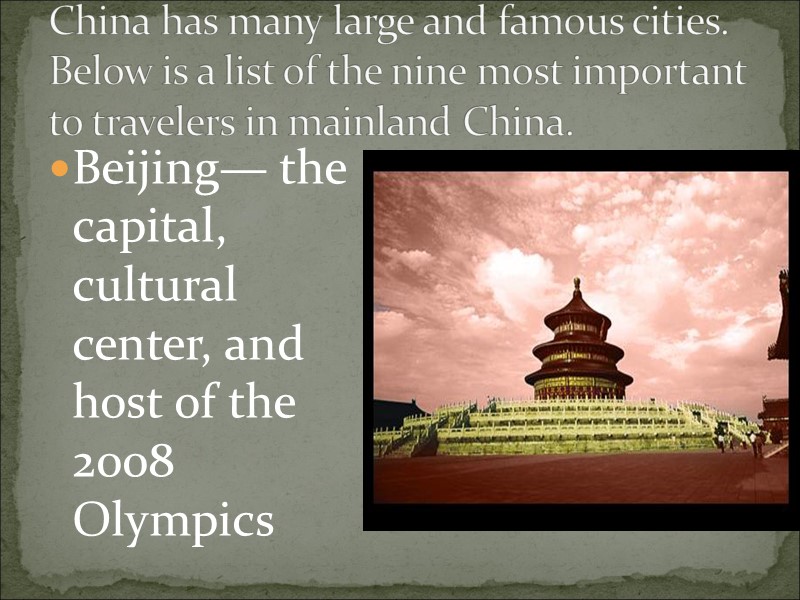
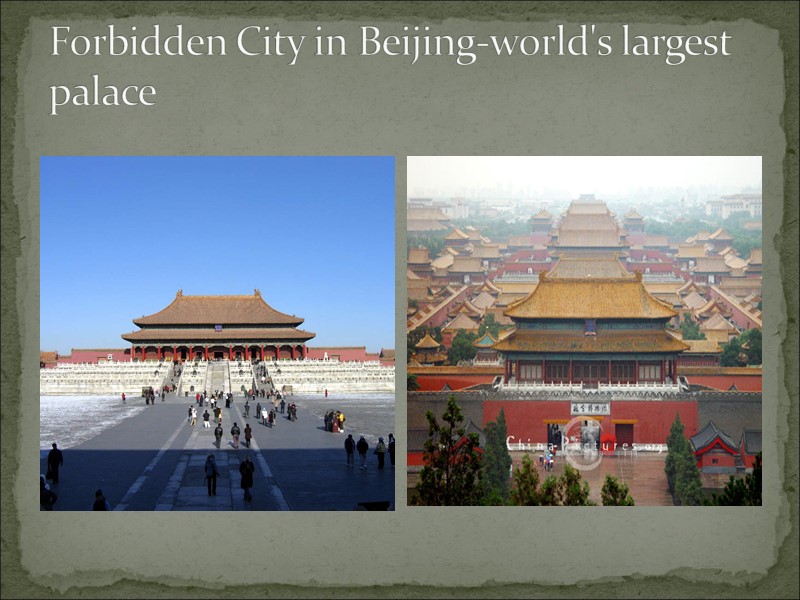
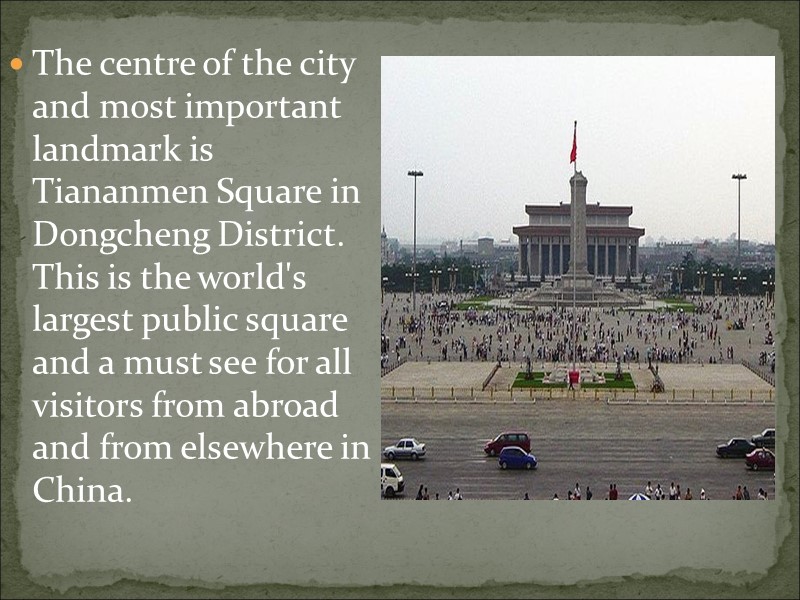
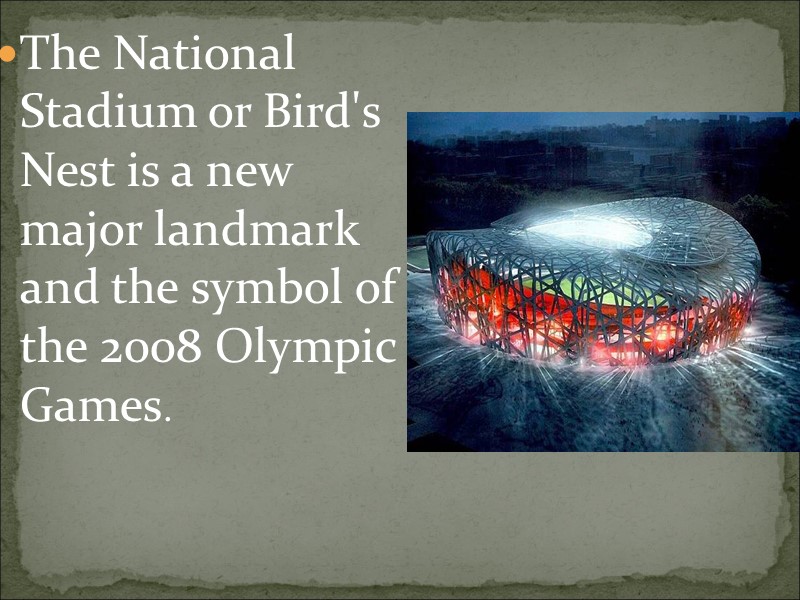
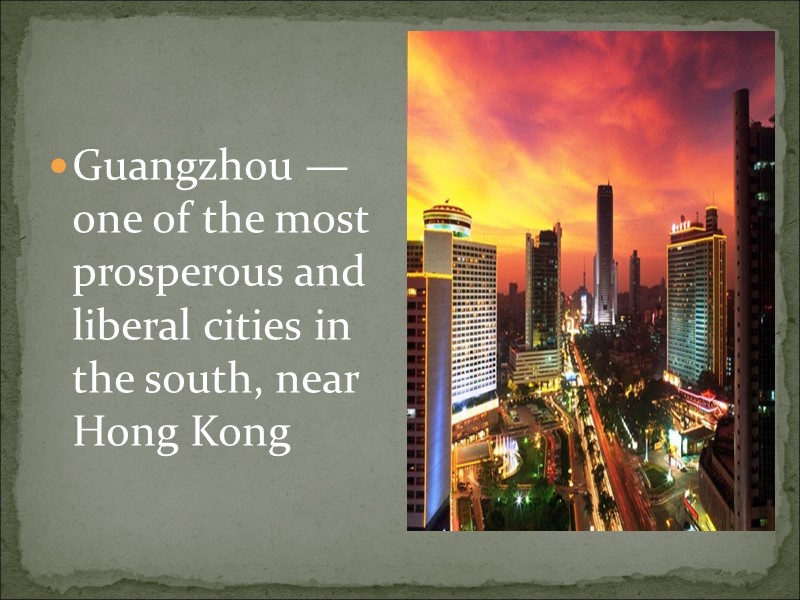
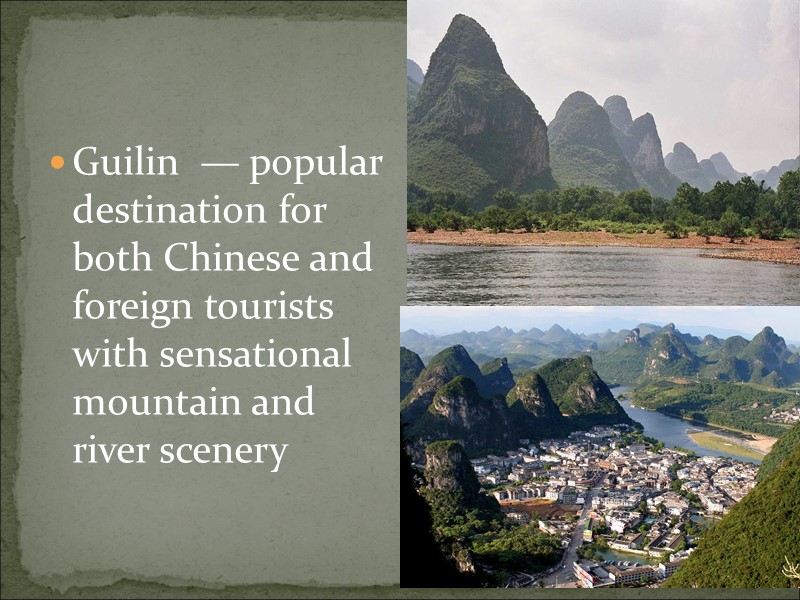
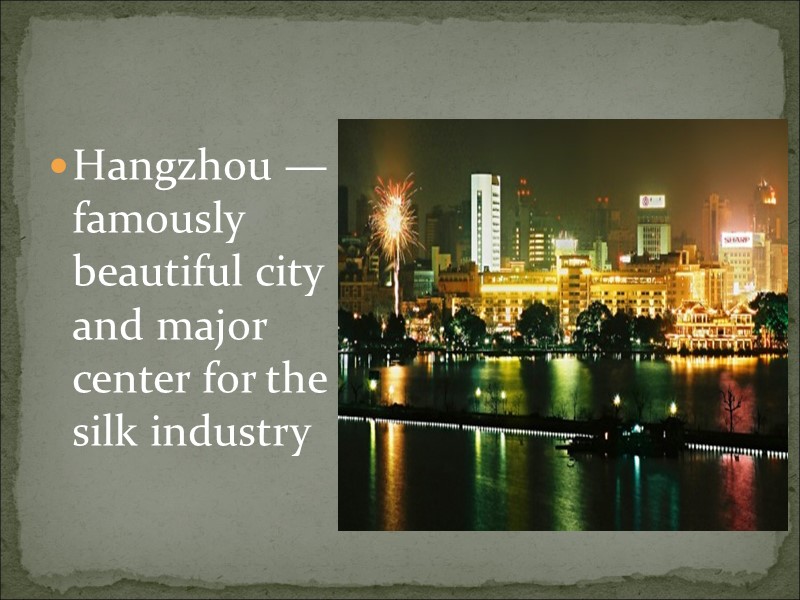
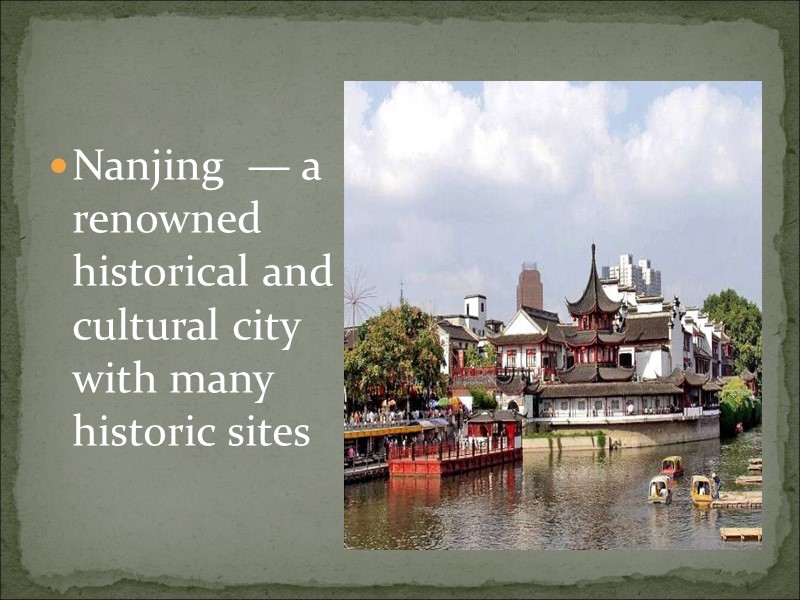
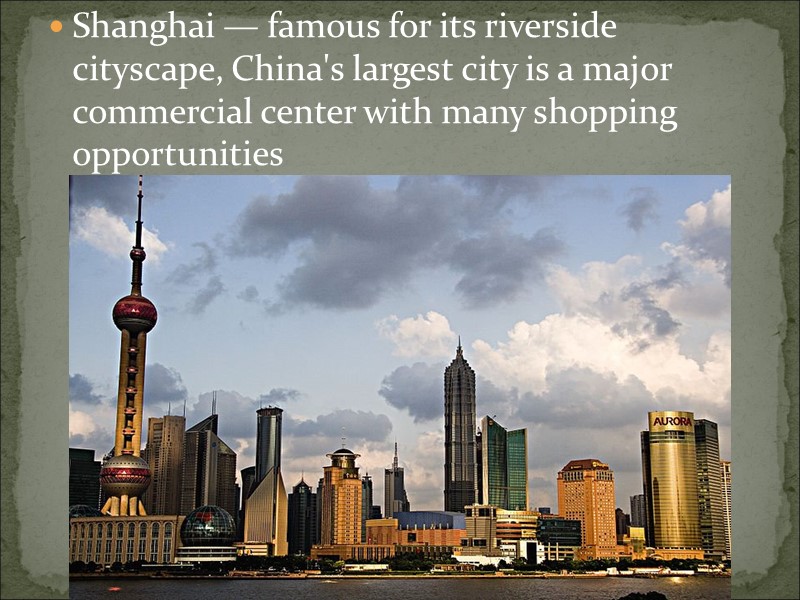
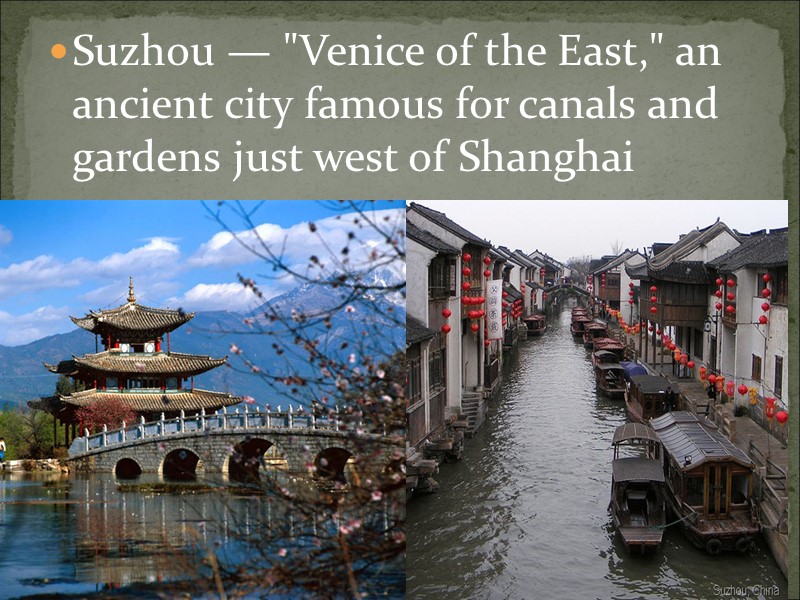
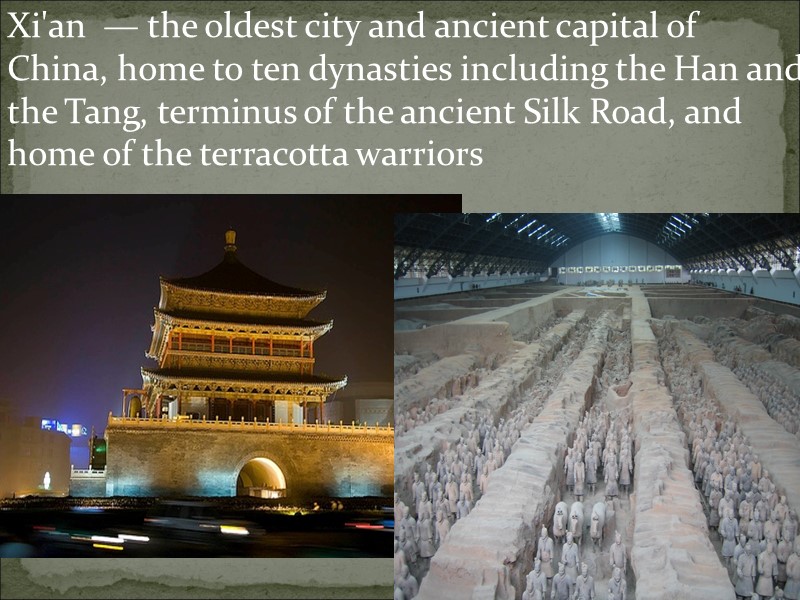
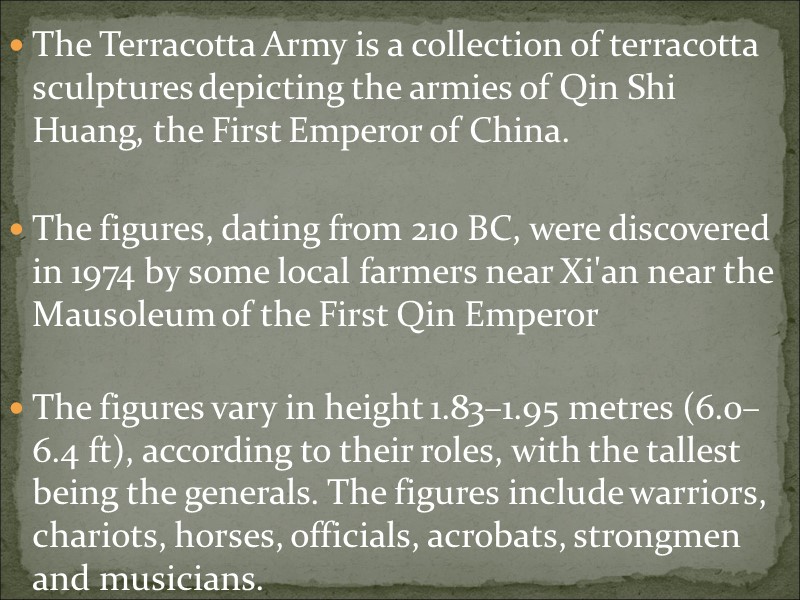
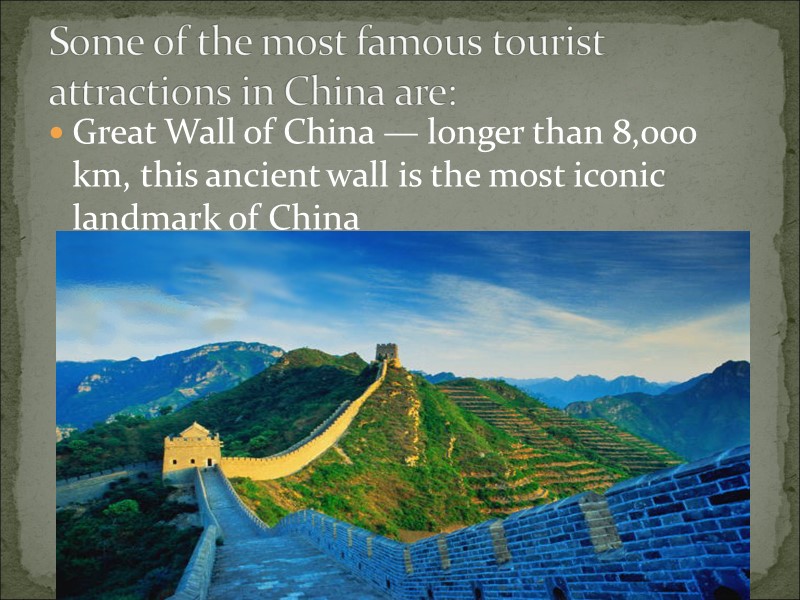
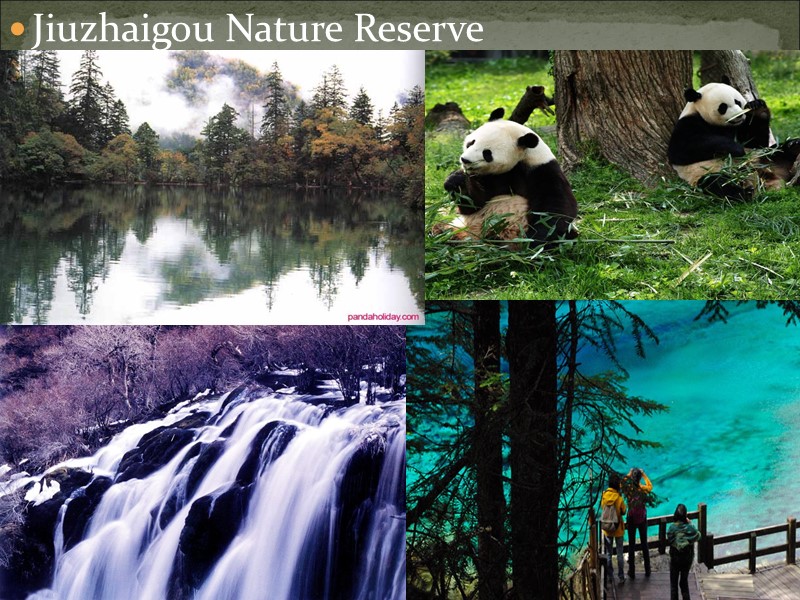
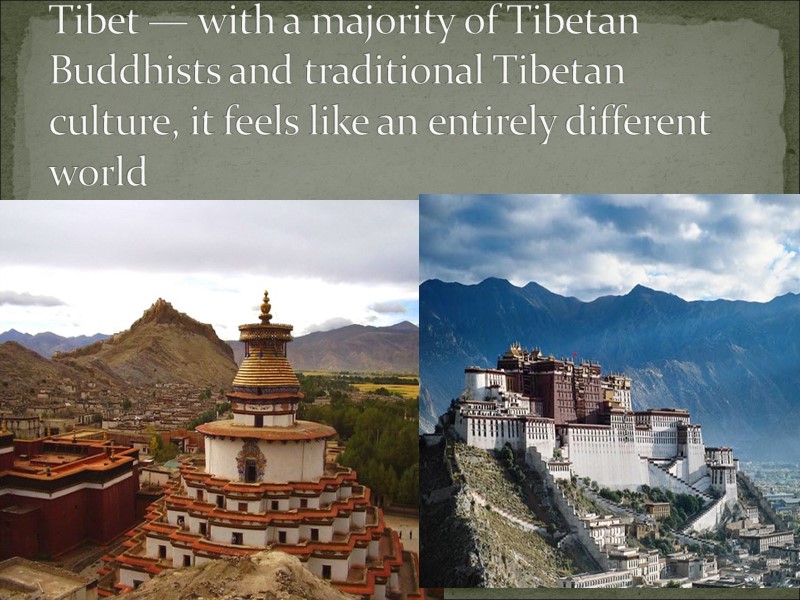
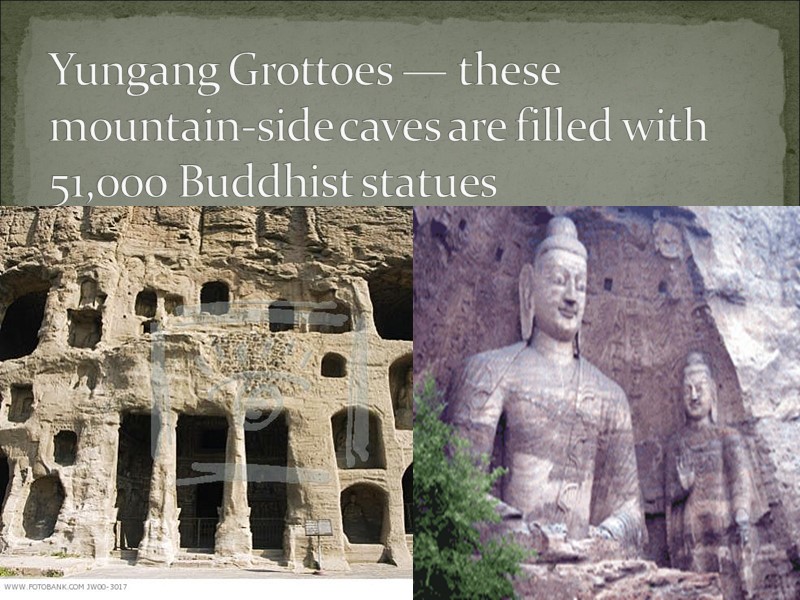
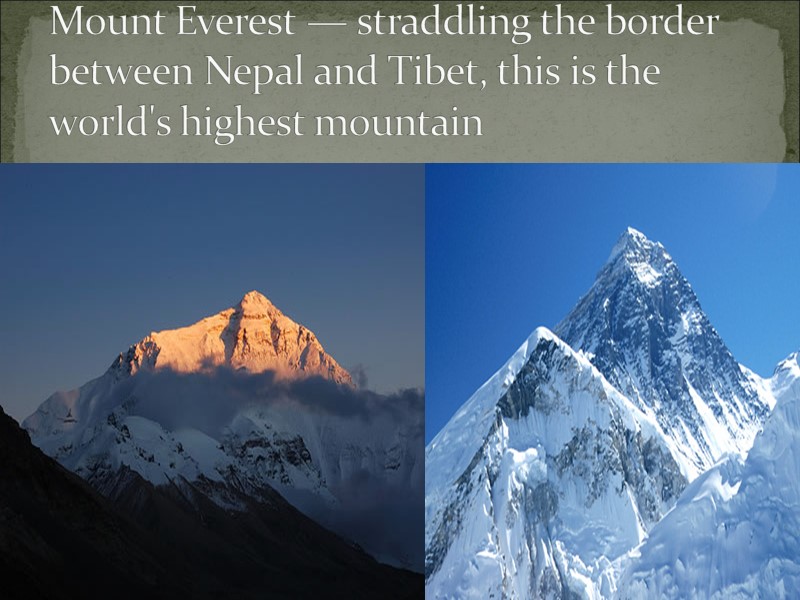

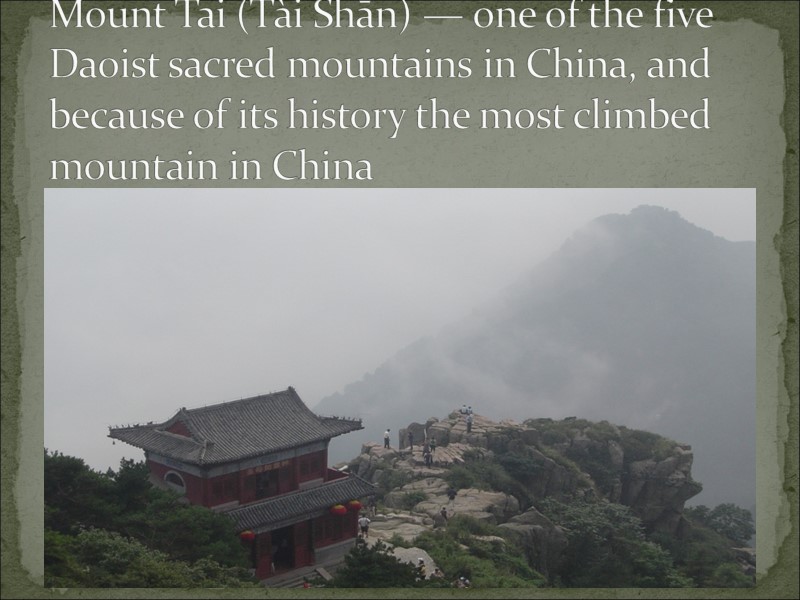
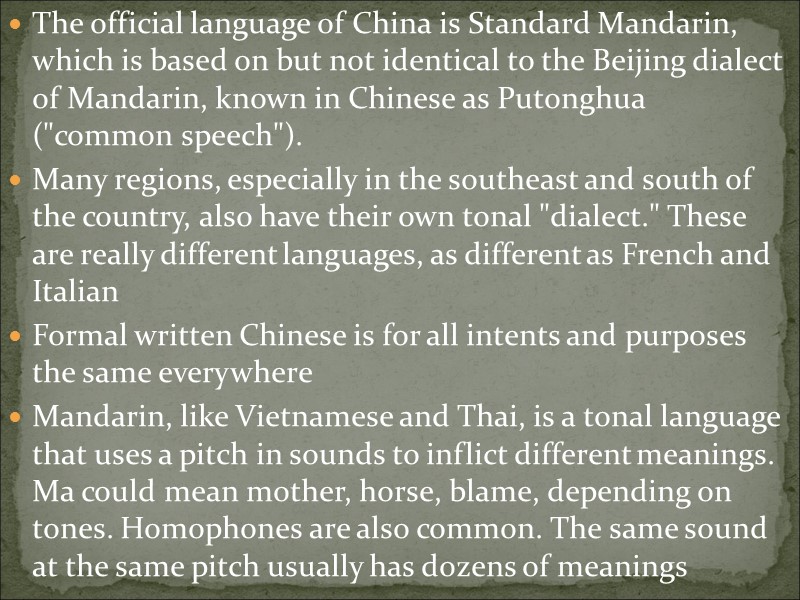
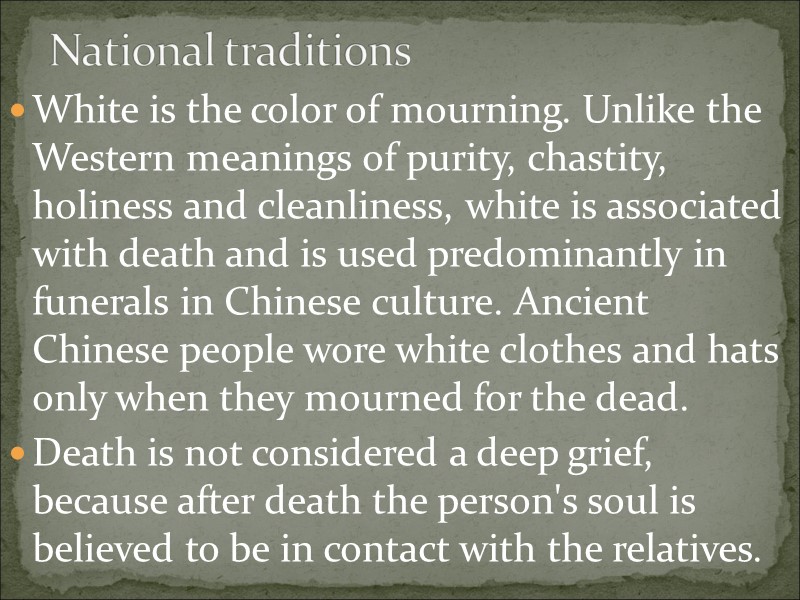
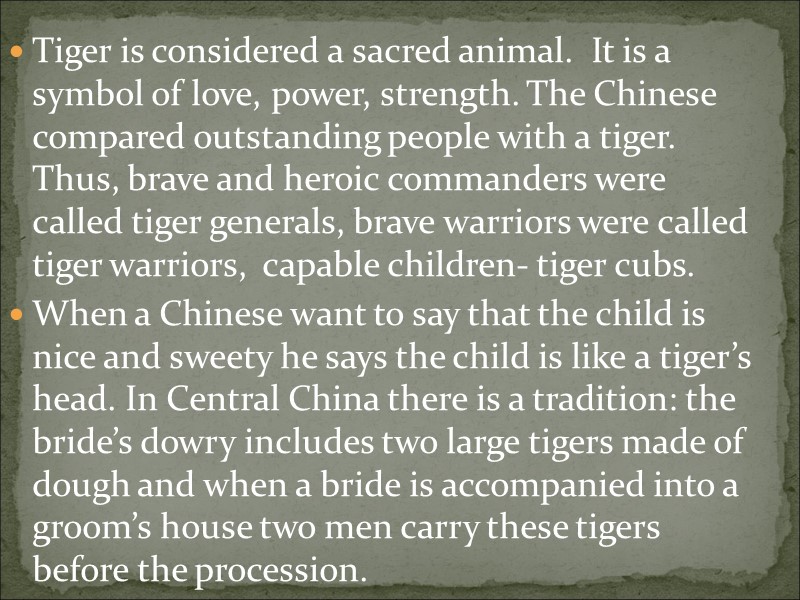
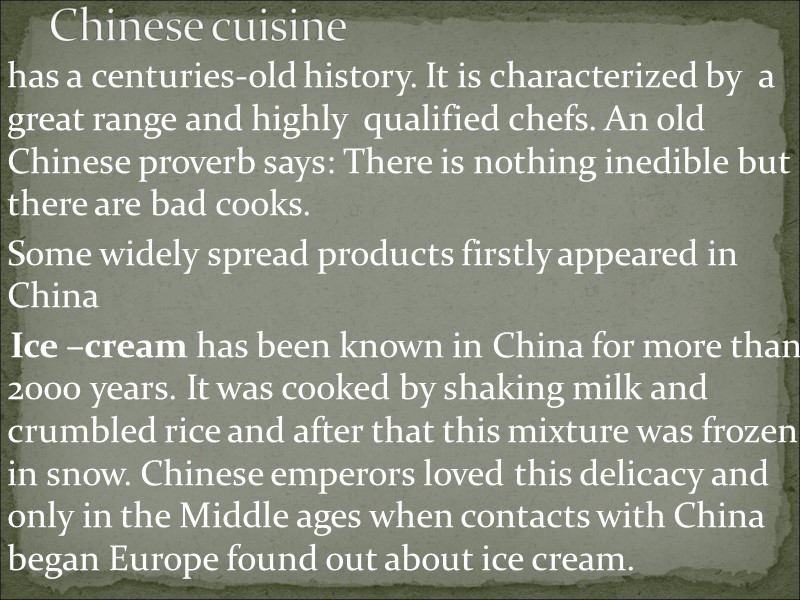
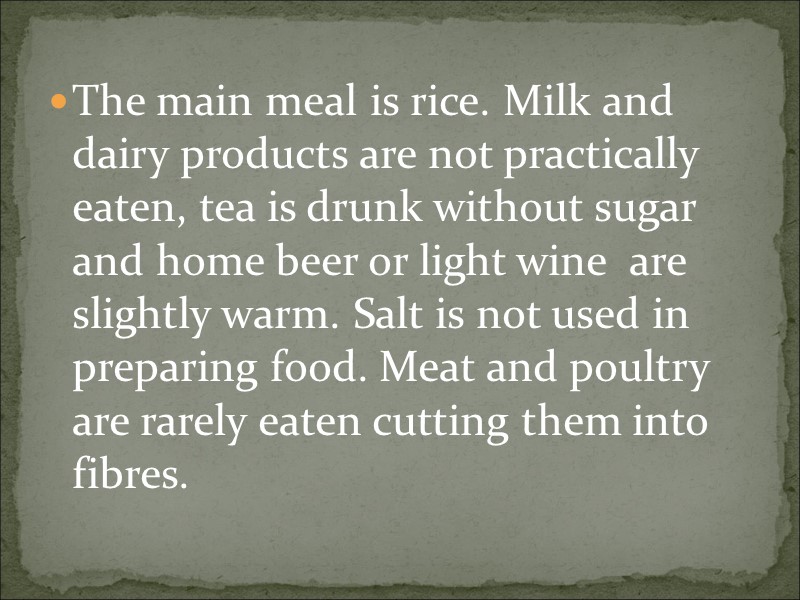
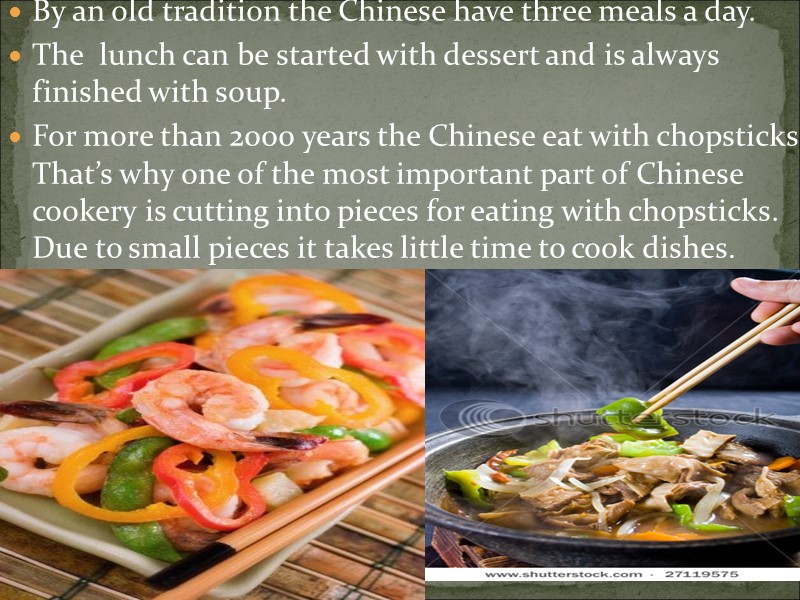
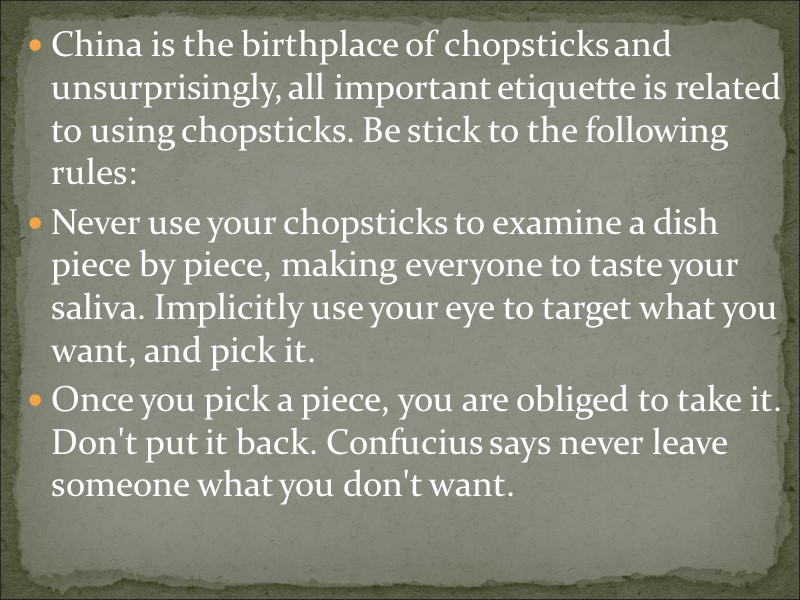
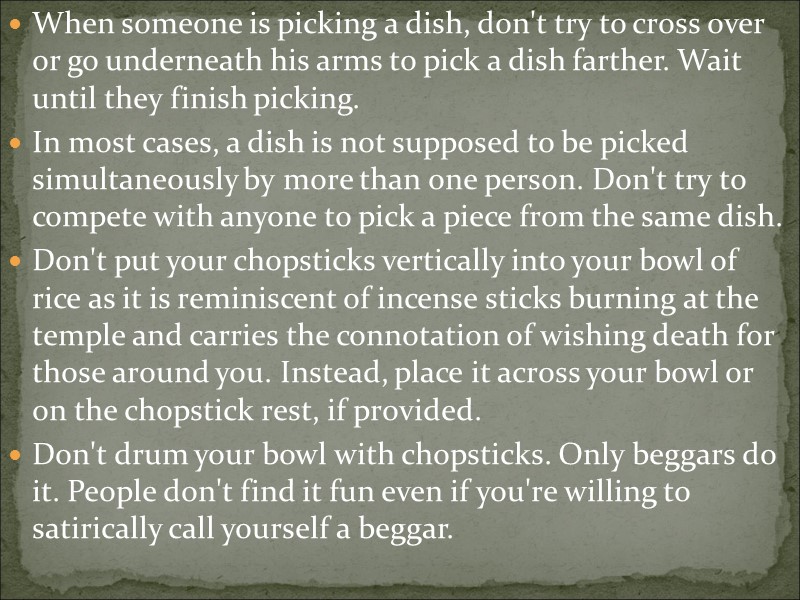
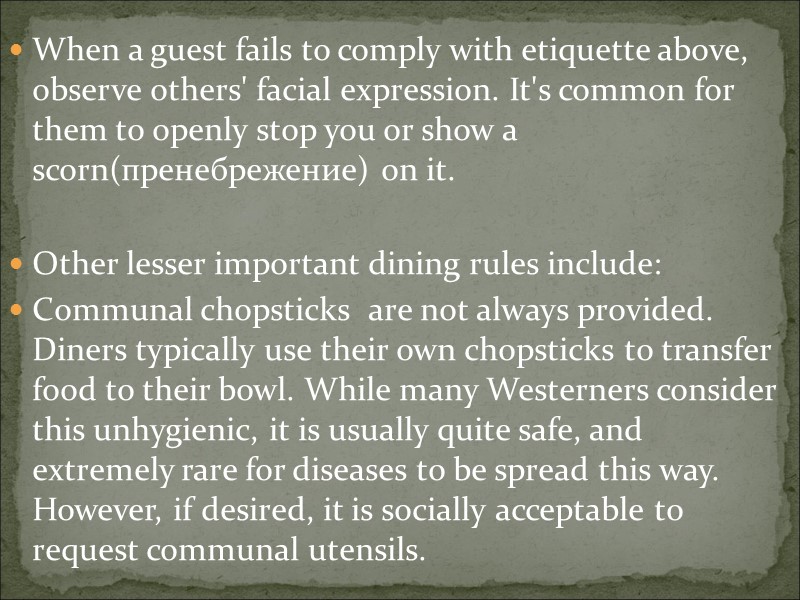
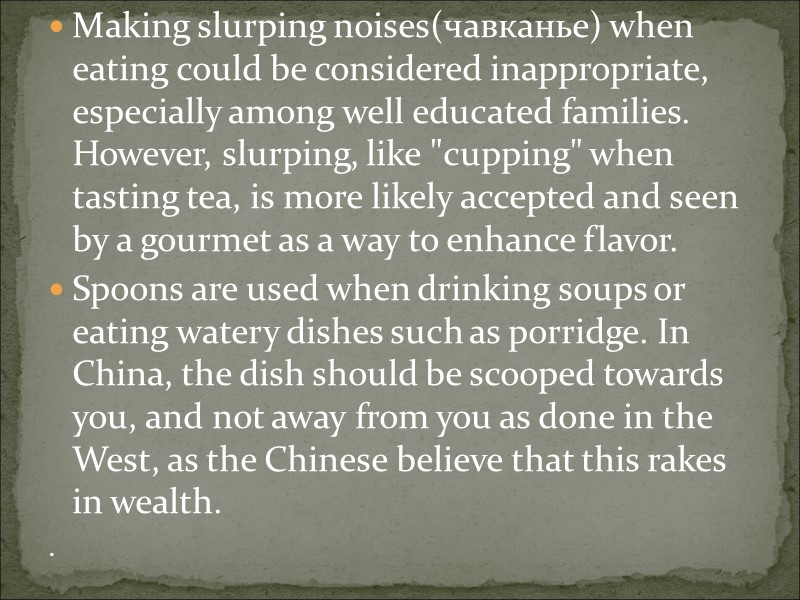
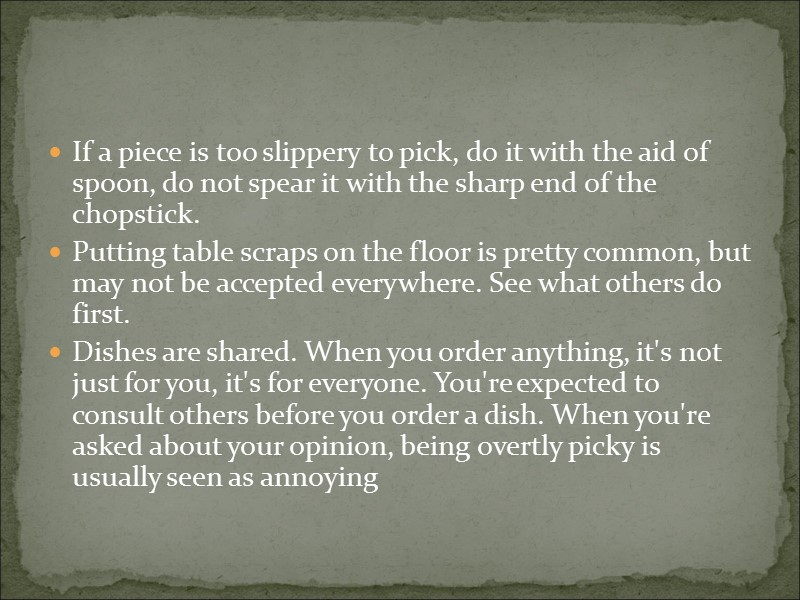
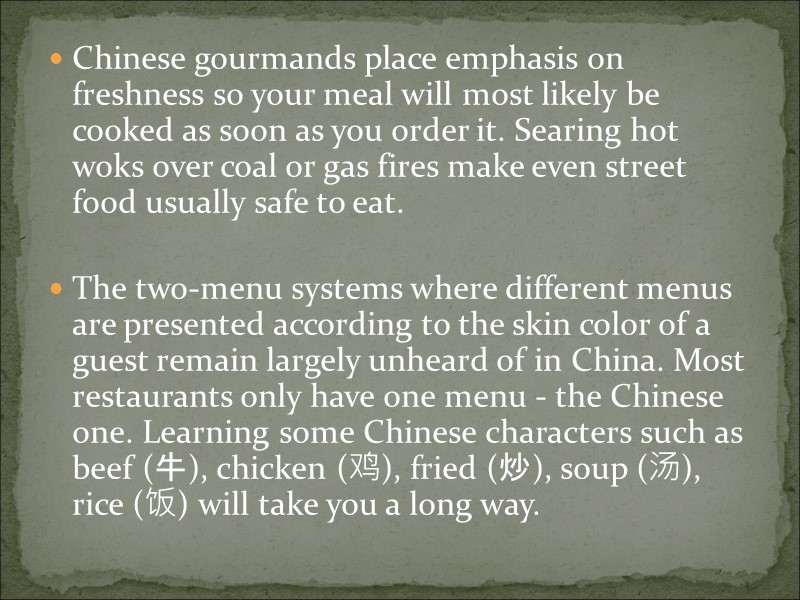
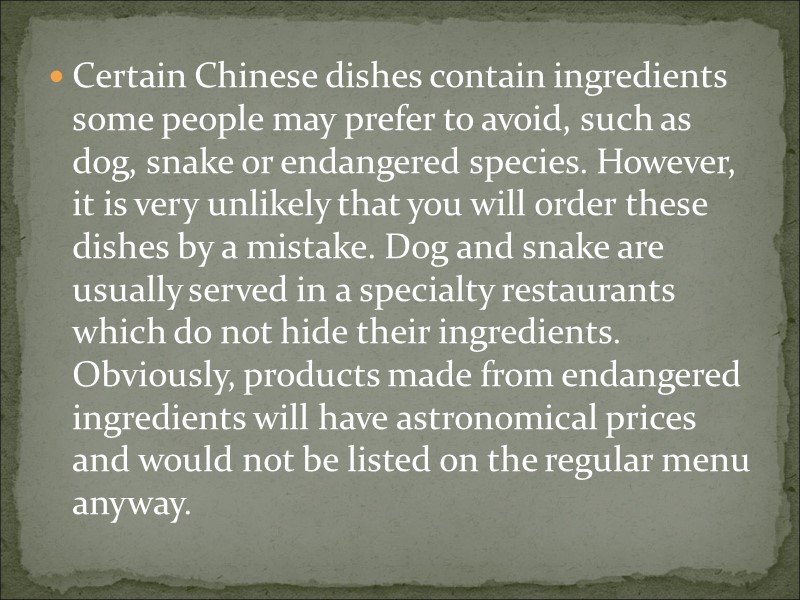
29348-central_and_southern_asia.ppt
- Количество слайдов: 50
 Central and Southern Asia China Japan
Central and Southern Asia China Japan
 China is the most populated country in the world -1.3 billion people
China is the most populated country in the world -1.3 billion people
 China has the greatest number of old people in the world, e.g. in the province Sichuan there are more than one thousand long-lived people whose age is 100 and more. Population
China has the greatest number of old people in the world, e.g. in the province Sichuan there are more than one thousand long-lived people whose age is 100 and more. Population
 The first civilizations in China arose in the Yangtze and Yellow River valleys at about the same time as Mesopotamia, Egypt and India developed their first civilizations. For centuries China stood as a leading civilization, outpacing the rest of the world in the arts and sciences. Paper, gunpowder, the compass and printing are Chinese inventions. Chinese developments in astronomy, medicine, and other fields were extensive History
The first civilizations in China arose in the Yangtze and Yellow River valleys at about the same time as Mesopotamia, Egypt and India developed their first civilizations. For centuries China stood as a leading civilization, outpacing the rest of the world in the arts and sciences. Paper, gunpowder, the compass and printing are Chinese inventions. Chinese developments in astronomy, medicine, and other fields were extensive History
 A Chinese tomb contains a heliocentric model of the solar system, about 1,700 years before Copernicus. In mathematics, the Pythagorean theorem and Pascal's triangle (known in China as Yang Hui's triangle) were known in China centuries before their Western discoverers lived. There were also grand feats of engineering not to be matched in Europe until centuries later, such as the Dujiangyan Irrigation( Орошение) System in Sichuan built during the Qin Dynasty, and the Grand Canal from Beijing to Hangzhou with its complex system of locks(шлюзы), built during the Sui Dynasty.
A Chinese tomb contains a heliocentric model of the solar system, about 1,700 years before Copernicus. In mathematics, the Pythagorean theorem and Pascal's triangle (known in China as Yang Hui's triangle) were known in China centuries before their Western discoverers lived. There were also grand feats of engineering not to be matched in Europe until centuries later, such as the Dujiangyan Irrigation( Орошение) System in Sichuan built during the Qin Dynasty, and the Grand Canal from Beijing to Hangzhou with its complex system of locks(шлюзы), built during the Sui Dynasty.
 China was also the first civilization to implement a meritocracy. Unlike other ancient cultures, official posts were not hereditary but had to be earned through a series of examinations. Based on mastery of the Confucian Classics and the literary arts (calligraphy, essay writing, poetry, painting), a prototype the exams were first conducted during the Han Dynasty.
China was also the first civilization to implement a meritocracy. Unlike other ancient cultures, official posts were not hereditary but had to be earned through a series of examinations. Based on mastery of the Confucian Classics and the literary arts (calligraphy, essay writing, poetry, painting), a prototype the exams were first conducted during the Han Dynasty.
 Chinese influence is quite apparent in the traditional culture of many of its neighbors, most notably Vietnam, Korea and Japan. Each of these countries adopted the Chinese writing system at some point, and it is still in use, to varying degrees and with certain modifications, in the latter two today. Confucian philosophy and social theory deeply influenced their societies.
Chinese influence is quite apparent in the traditional culture of many of its neighbors, most notably Vietnam, Korea and Japan. Each of these countries adopted the Chinese writing system at some point, and it is still in use, to varying degrees and with certain modifications, in the latter two today. Confucian philosophy and social theory deeply influenced their societies.
 China also explored widely and traded extensively with distant lands. By the 5th and 6th centuries CE, voyages to India and the Arab countries were routine. In the 15th century, the Ming Dynasty fleets under Admiral Zheng He reached as far as East Africa. These ships were technologically very advanced, much larger than European ships of the day, and equipped with a system of watertight compartments (водонепроницаемый отсек) that Europe was not to match for several centuries
China also explored widely and traded extensively with distant lands. By the 5th and 6th centuries CE, voyages to India and the Arab countries were routine. In the 15th century, the Ming Dynasty fleets under Admiral Zheng He reached as far as East Africa. These ships were technologically very advanced, much larger than European ships of the day, and equipped with a system of watertight compartments (водонепроницаемый отсек) that Europe was not to match for several centuries
 China is a one-party authoritarian state ruled by the Communist Party of China. China is a very diverse place with large variations in culture, language, customs and economic levels. The economic landscape is particularly diverse.
China is a one-party authoritarian state ruled by the Communist Party of China. China is a very diverse place with large variations in culture, language, customs and economic levels. The economic landscape is particularly diverse.
 The major cities such as Beijing, Guangzhou and Shanghai are modern and comparatively wealthy. However, about 50% of Chinese still live in rural areas even though only 10% of China's land is arable(пахо тный).
The major cities such as Beijing, Guangzhou and Shanghai are modern and comparatively wealthy. However, about 50% of Chinese still live in rural areas even though only 10% of China's land is arable(пахо тный).
 Staring: This is common through most of the country. The staring usually originates out of sheer curiosity (чистое любопытство), almost never out of hostility. Don't be surprised if someone comes right up to you and just looks as if they are watching the TV, no harm done! Some behaviours that are quite normal in China may be somewhat jarring and vulgar for foreigners:
Staring: This is common through most of the country. The staring usually originates out of sheer curiosity (чистое любопытство), almost never out of hostility. Don't be surprised if someone comes right up to you and just looks as if they are watching the TV, no harm done! Some behaviours that are quite normal in China may be somewhat jarring and vulgar for foreigners:
 Spitting: in the street, shops, supermarkets, hotel lobbies, hallways, restaurants, on buses and even in hospitals. Traditional Chinese medical thought believes it is unhealthy to swallow phlegm. Spitting has declined considerably in more developed urban areas like Beijing and Shanghai since the SARS epidemic of 2002. However, in most other areas the habit persists to varying degrees, from moderate to ever-present.
Spitting: in the street, shops, supermarkets, hotel lobbies, hallways, restaurants, on buses and even in hospitals. Traditional Chinese medical thought believes it is unhealthy to swallow phlegm. Spitting has declined considerably in more developed urban areas like Beijing and Shanghai since the SARS epidemic of 2002. However, in most other areas the habit persists to varying degrees, from moderate to ever-present.
 Loud conversations, noise, discussions or public arguments: These are very common. Many mainland Chinese speak very loudly in public (including in the early mornings) and it may be one of the first things you notice upon arrival. Loud speech usually does not mean that the speaker is angry or engaged in an argument (although obviously it can).
Loud conversations, noise, discussions or public arguments: These are very common. Many mainland Chinese speak very loudly in public (including in the early mornings) and it may be one of the first things you notice upon arrival. Loud speech usually does not mean that the speaker is angry or engaged in an argument (although obviously it can).
 National Day - 1 October China has five major annual holidays:
National Day - 1 October China has five major annual holidays:
 Chinese New Year or Spring Festival late January/mid-February
Chinese New Year or Spring Festival late January/mid-February
 Dragon Boat Festival - 5th day of the 5th lunar month, usually May-June (Boat races and eating zongzi ( steamed pouches of sticky rice) are a traditional parts of the celebration.
Dragon Boat Festival - 5th day of the 5th lunar month, usually May-June (Boat races and eating zongzi ( steamed pouches of sticky rice) are a traditional parts of the celebration.
 Mid-Autumn Day - 15th day of the 8th lunar month, usually October. Also called the Moon Cake Festival after its signature treat, moon cakes.People meet outside, putting food on tables and looking up at the full harvest moon while talking about life.
Mid-Autumn Day - 15th day of the 8th lunar month, usually October. Also called the Moon Cake Festival after its signature treat, moon cakes.People meet outside, putting food on tables and looking up at the full harvest moon while talking about life.
 Lantern Festival - 15th day of the 1st lunar month, just after Chinese New Year, usually in February or March. In some cities, such as Quanzhou, this is a big festival with elaborate lanterns all over town.
Lantern Festival - 15th day of the 1st lunar month, just after Chinese New Year, usually in February or March. In some cities, such as Quanzhou, this is a big festival with elaborate lanterns all over town.
 China has many large and famous cities. Below is a list of the nine most important to travelers in mainland China. Beijing— the capital, cultural center, and host of the 2008 Olympics
China has many large and famous cities. Below is a list of the nine most important to travelers in mainland China. Beijing— the capital, cultural center, and host of the 2008 Olympics
 Forbidden City in Beijing-world's largest palace
Forbidden City in Beijing-world's largest palace
 The centre of the city and most important landmark is Tiananmen Square in Dongcheng District. This is the world's largest public square and a must see for all visitors from abroad and from elsewhere in China.
The centre of the city and most important landmark is Tiananmen Square in Dongcheng District. This is the world's largest public square and a must see for all visitors from abroad and from elsewhere in China.
 The National Stadium or Bird's Nest is a new major landmark and the symbol of the 2008 Olympic Games.
The National Stadium or Bird's Nest is a new major landmark and the symbol of the 2008 Olympic Games.
 Guangzhou — one of the most prosperous and liberal cities in the south, near Hong Kong
Guangzhou — one of the most prosperous and liberal cities in the south, near Hong Kong
 Guilin — popular destination for both Chinese and foreign tourists with sensational mountain and river scenery
Guilin — popular destination for both Chinese and foreign tourists with sensational mountain and river scenery
 Hangzhou — famously beautiful city and major center for the silk industry
Hangzhou — famously beautiful city and major center for the silk industry
 Nanjing — a renowned historical and cultural city with many historic sites
Nanjing — a renowned historical and cultural city with many historic sites
 Shanghai — famous for its riverside cityscape, China's largest city is a major commercial center with many shopping opportunities
Shanghai — famous for its riverside cityscape, China's largest city is a major commercial center with many shopping opportunities
 Suzhou — "Venice of the East," an ancient city famous for canals and gardens just west of Shanghai
Suzhou — "Venice of the East," an ancient city famous for canals and gardens just west of Shanghai
 Xi'an — the oldest city and ancient capital of China, home to ten dynasties including the Han and the Tang, terminus of the ancient Silk Road, and home of the terracotta warriors
Xi'an — the oldest city and ancient capital of China, home to ten dynasties including the Han and the Tang, terminus of the ancient Silk Road, and home of the terracotta warriors
 The Terracotta Army is a collection of terracotta sculptures depicting the armies of Qin Shi Huang, the First Emperor of China. The figures, dating from 210 BC, were discovered in 1974 by some local farmers near Xi'an near the Mausoleum of the First Qin Emperor The figures vary in height 1.83–1.95 metres (6.0–6.4 ft), according to their roles, with the tallest being the generals. The figures include warriors, chariots, horses, officials, acrobats, strongmen and musicians.
The Terracotta Army is a collection of terracotta sculptures depicting the armies of Qin Shi Huang, the First Emperor of China. The figures, dating from 210 BC, were discovered in 1974 by some local farmers near Xi'an near the Mausoleum of the First Qin Emperor The figures vary in height 1.83–1.95 metres (6.0–6.4 ft), according to their roles, with the tallest being the generals. The figures include warriors, chariots, horses, officials, acrobats, strongmen and musicians.
 Great Wall of China — longer than 8,000 km, this ancient wall is the most iconic landmark of China Some of the most famous tourist attractions in China are:
Great Wall of China — longer than 8,000 km, this ancient wall is the most iconic landmark of China Some of the most famous tourist attractions in China are:
 Jiuzhaigou Nature Reserve
Jiuzhaigou Nature Reserve
 Tibet — with a majority of Tibetan Buddhists and traditional Tibetan culture, it feels like an entirely different world
Tibet — with a majority of Tibetan Buddhists and traditional Tibetan culture, it feels like an entirely different world
 Yungang Grottoes — these mountain-side caves are filled with 51,000 Buddhist statues
Yungang Grottoes — these mountain-side caves are filled with 51,000 Buddhist statues
 Mount Everest — straddling the border between Nepal and Tibet, this is the world's highest mountain
Mount Everest — straddling the border between Nepal and Tibet, this is the world's highest mountain
 Hainan — a tropical paradise island undergoing heavy tourist-oriented development
Hainan — a tropical paradise island undergoing heavy tourist-oriented development
 Mount Tai (Tài Shān) — one of the five Daoist sacred mountains in China, and because of its history the most climbed mountain in China
Mount Tai (Tài Shān) — one of the five Daoist sacred mountains in China, and because of its history the most climbed mountain in China
 The official language of China is Standard Mandarin, which is based on but not identical to the Beijing dialect of Mandarin, known in Chinese as Putonghua ("common speech"). Many regions, especially in the southeast and south of the country, also have their own tonal "dialect." These are really different languages, as different as French and Italian Formal written Chinese is for all intents and purposes the same everywhere Mandarin, like Vietnamese and Thai, is a tonal language that uses a pitch in sounds to inflict different meanings. Ma could mean mother, horse, blame, depending on tones. Homophones are also common. The same sound at the same pitch usually has dozens of meanings
The official language of China is Standard Mandarin, which is based on but not identical to the Beijing dialect of Mandarin, known in Chinese as Putonghua ("common speech"). Many regions, especially in the southeast and south of the country, also have their own tonal "dialect." These are really different languages, as different as French and Italian Formal written Chinese is for all intents and purposes the same everywhere Mandarin, like Vietnamese and Thai, is a tonal language that uses a pitch in sounds to inflict different meanings. Ma could mean mother, horse, blame, depending on tones. Homophones are also common. The same sound at the same pitch usually has dozens of meanings
 White is the color of mourning. Unlike the Western meanings of purity, chastity, holiness and cleanliness, white is associated with death and is used predominantly in funerals in Chinese culture. Ancient Chinese people wore white clothes and hats only when they mourned for the dead. Death is not considered a deep grief, because after death the person's soul is believed to be in contact with the relatives. National traditions
White is the color of mourning. Unlike the Western meanings of purity, chastity, holiness and cleanliness, white is associated with death and is used predominantly in funerals in Chinese culture. Ancient Chinese people wore white clothes and hats only when they mourned for the dead. Death is not considered a deep grief, because after death the person's soul is believed to be in contact with the relatives. National traditions
 Tiger is considered a sacred animal. It is a symbol of love, power, strength. The Chinese compared outstanding people with a tiger. Thus, brave and heroic commanders were called tiger generals, brave warriors were called tiger warriors, capable children- tiger cubs. When a Chinese want to say that the child is nice and sweety he says the child is like a tiger’s head. In Central China there is a tradition: the bride’s dowry includes two large tigers made of dough and when a bride is accompanied into a groom’s house two men carry these tigers before the procession.
Tiger is considered a sacred animal. It is a symbol of love, power, strength. The Chinese compared outstanding people with a tiger. Thus, brave and heroic commanders were called tiger generals, brave warriors were called tiger warriors, capable children- tiger cubs. When a Chinese want to say that the child is nice and sweety he says the child is like a tiger’s head. In Central China there is a tradition: the bride’s dowry includes two large tigers made of dough and when a bride is accompanied into a groom’s house two men carry these tigers before the procession.
 has a centuries-old history. It is characterized by a great range and highly qualified chefs. An old Chinese proverb says: There is nothing inedible but there are bad cooks. Some widely spread products firstly appeared in China Ice –cream has been known in China for more than 2000 years. It was cooked by shaking milk and crumbled rice and after that this mixture was frozen in snow. Chinese emperors loved this delicacy and only in the Middle ages when contacts with China began Europe found out about ice cream. Chinese cuisine
has a centuries-old history. It is characterized by a great range and highly qualified chefs. An old Chinese proverb says: There is nothing inedible but there are bad cooks. Some widely spread products firstly appeared in China Ice –cream has been known in China for more than 2000 years. It was cooked by shaking milk and crumbled rice and after that this mixture was frozen in snow. Chinese emperors loved this delicacy and only in the Middle ages when contacts with China began Europe found out about ice cream. Chinese cuisine
 The main meal is rice. Milk and dairy products are not practically eaten, tea is drunk without sugar and home beer or light wine are slightly warm. Salt is not used in preparing food. Meat and poultry are rarely eaten cutting them into fibres.
The main meal is rice. Milk and dairy products are not practically eaten, tea is drunk without sugar and home beer or light wine are slightly warm. Salt is not used in preparing food. Meat and poultry are rarely eaten cutting them into fibres.
 By an old tradition the Chinese have three meals a day. The lunch can be started with dessert and is always finished with soup. For more than 2000 years the Chinese eat with chopsticks. That’s why one of the most important part of Chinese cookery is cutting into pieces for eating with chopsticks. Due to small pieces it takes little time to cook dishes.
By an old tradition the Chinese have three meals a day. The lunch can be started with dessert and is always finished with soup. For more than 2000 years the Chinese eat with chopsticks. That’s why one of the most important part of Chinese cookery is cutting into pieces for eating with chopsticks. Due to small pieces it takes little time to cook dishes.
 China is the birthplace of chopsticks and unsurprisingly, all important etiquette is related to using chopsticks. Be stick to the following rules: Never use your chopsticks to examine a dish piece by piece, making everyone to taste your saliva. Implicitly use your eye to target what you want, and pick it. Once you pick a piece, you are obliged to take it. Don't put it back. Confucius says never leave someone what you don't want.
China is the birthplace of chopsticks and unsurprisingly, all important etiquette is related to using chopsticks. Be stick to the following rules: Never use your chopsticks to examine a dish piece by piece, making everyone to taste your saliva. Implicitly use your eye to target what you want, and pick it. Once you pick a piece, you are obliged to take it. Don't put it back. Confucius says never leave someone what you don't want.
 When someone is picking a dish, don't try to cross over or go underneath his arms to pick a dish farther. Wait until they finish picking. In most cases, a dish is not supposed to be picked simultaneously by more than one person. Don't try to compete with anyone to pick a piece from the same dish. Don't put your chopsticks vertically into your bowl of rice as it is reminiscent of incense sticks burning at the temple and carries the connotation of wishing death for those around you. Instead, place it across your bowl or on the chopstick rest, if provided. Don't drum your bowl with chopsticks. Only beggars do it. People don't find it fun even if you're willing to satirically call yourself a beggar.
When someone is picking a dish, don't try to cross over or go underneath his arms to pick a dish farther. Wait until they finish picking. In most cases, a dish is not supposed to be picked simultaneously by more than one person. Don't try to compete with anyone to pick a piece from the same dish. Don't put your chopsticks vertically into your bowl of rice as it is reminiscent of incense sticks burning at the temple and carries the connotation of wishing death for those around you. Instead, place it across your bowl or on the chopstick rest, if provided. Don't drum your bowl with chopsticks. Only beggars do it. People don't find it fun even if you're willing to satirically call yourself a beggar.
 When a guest fails to comply with etiquette above, observe others' facial expression. It's common for them to openly stop you or show a scorn(пренебрежение) on it. Other lesser important dining rules include: Communal chopsticks are not always provided. Diners typically use their own chopsticks to transfer food to their bowl. While many Westerners consider this unhygienic, it is usually quite safe, and extremely rare for diseases to be spread this way. However, if desired, it is socially acceptable to request communal utensils.
When a guest fails to comply with etiquette above, observe others' facial expression. It's common for them to openly stop you or show a scorn(пренебрежение) on it. Other lesser important dining rules include: Communal chopsticks are not always provided. Diners typically use their own chopsticks to transfer food to their bowl. While many Westerners consider this unhygienic, it is usually quite safe, and extremely rare for diseases to be spread this way. However, if desired, it is socially acceptable to request communal utensils.
 Making slurping noises(чавканье) when eating could be considered inappropriate, especially among well educated families. However, slurping, like "cupping" when tasting tea, is more likely accepted and seen by a gourmet as a way to enhance flavor. Spoons are used when drinking soups or eating watery dishes such as porridge. In China, the dish should be scooped towards you, and not away from you as done in the West, as the Chinese believe that this rakes in wealth. .
Making slurping noises(чавканье) when eating could be considered inappropriate, especially among well educated families. However, slurping, like "cupping" when tasting tea, is more likely accepted and seen by a gourmet as a way to enhance flavor. Spoons are used when drinking soups or eating watery dishes such as porridge. In China, the dish should be scooped towards you, and not away from you as done in the West, as the Chinese believe that this rakes in wealth. .
 If a piece is too slippery to pick, do it with the aid of spoon, do not spear it with the sharp end of the chopstick. Putting table scraps on the floor is pretty common, but may not be accepted everywhere. See what others do first. Dishes are shared. When you order anything, it's not just for you, it's for everyone. You're expected to consult others before you order a dish. When you're asked about your opinion, being overtly picky is usually seen as annoying
If a piece is too slippery to pick, do it with the aid of spoon, do not spear it with the sharp end of the chopstick. Putting table scraps on the floor is pretty common, but may not be accepted everywhere. See what others do first. Dishes are shared. When you order anything, it's not just for you, it's for everyone. You're expected to consult others before you order a dish. When you're asked about your opinion, being overtly picky is usually seen as annoying
 Chinese gourmands place emphasis on freshness so your meal will most likely be cooked as soon as you order it. Searing hot woks over coal or gas fires make even street food usually safe to eat. The two-menu systems where different menus are presented according to the skin color of a guest remain largely unheard of in China. Most restaurants only have one menu - the Chinese one. Learning some Chinese characters such as beef (牛), chicken (鸡), fried (炒), soup (汤), rice (饭) will take you a long way.
Chinese gourmands place emphasis on freshness so your meal will most likely be cooked as soon as you order it. Searing hot woks over coal or gas fires make even street food usually safe to eat. The two-menu systems where different menus are presented according to the skin color of a guest remain largely unheard of in China. Most restaurants only have one menu - the Chinese one. Learning some Chinese characters such as beef (牛), chicken (鸡), fried (炒), soup (汤), rice (饭) will take you a long way.
 Certain Chinese dishes contain ingredients some people may prefer to avoid, such as dog, snake or endangered species. However, it is very unlikely that you will order these dishes by a mistake. Dog and snake are usually served in a specialty restaurants which do not hide their ingredients. Obviously, products made from endangered ingredients will have astronomical prices and would not be listed on the regular menu anyway.
Certain Chinese dishes contain ingredients some people may prefer to avoid, such as dog, snake or endangered species. However, it is very unlikely that you will order these dishes by a mistake. Dog and snake are usually served in a specialty restaurants which do not hide their ingredients. Obviously, products made from endangered ingredients will have astronomical prices and would not be listed on the regular menu anyway.
